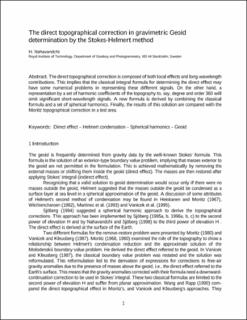| dc.contributor.author | Nahavandchi, Hossein | |
| dc.date.accessioned | 2023-10-19T07:56:59Z | |
| dc.date.available | 2023-10-19T07:56:59Z | |
| dc.date.created | 2002-02-11T00:00:00Z | |
| dc.date.issued | 2000 | |
| dc.identifier.citation | Journal of Geodesy. 2000, 74 (6), 488-496. | en_US |
| dc.identifier.issn | 0949-7714 | |
| dc.identifier.uri | https://hdl.handle.net/11250/3097459 | |
| dc.description.abstract | The direct topographical correction is composed of both local effects and long-wavelength contributions. This implies that the classical integral formula for determining the direct effect may have some numerical problems in representing these different signals. On the other hand, a representation by a set of harmonic coefficients of the topography to, say, degree and order 360 will omit significant short-wavelength signals. A new formula is derived by combining the classical formula and a set of spherical harmonics. Finally, the results of this solution are compared with the Moritz topographical correction in a test area. | en_US |
| dc.description.abstract | The direct topographical correction in gravimetric geoid determination by the Stokes-Helmert method | en_US |
| dc.language.iso | eng | en_US |
| dc.publisher | Springer | en_US |
| dc.title | The direct topographical correction in gravimetric geoid determination by the Stokes-Helmert method | en_US |
| dc.title.alternative | The direct topographical correction in gravimetric geoid determination by the Stokes-Helmert method | en_US |
| dc.type | Peer reviewed | en_US |
| dc.type | Journal article | en_US |
| dc.description.version | acceptedVersion | en_US |
| dc.rights.holder | © 2000 Springer Nature | en_US |
| dc.source.pagenumber | 488-496 | en_US |
| dc.source.volume | 74 | en_US |
| dc.source.journal | Journal of Geodesy | en_US |
| dc.source.issue | 6 | en_US |
| dc.identifier.doi | https://doi.org/10.1007/s001900000110 | |
| dc.identifier.cristin | 408482 | |
| cristin.ispublished | true | |
| cristin.fulltext | postprint | |
| cristin.fulltext | postprint | |
| cristin.qualitycode | 1 | |
